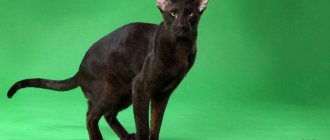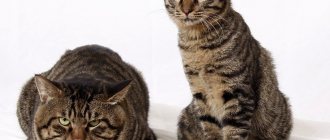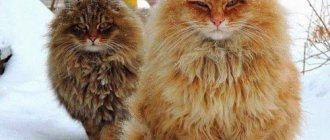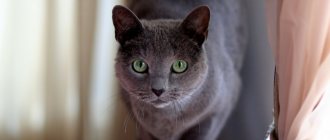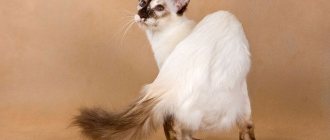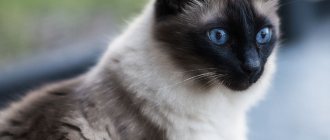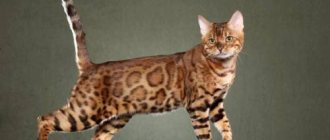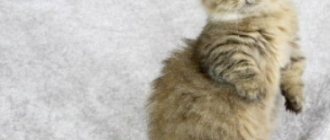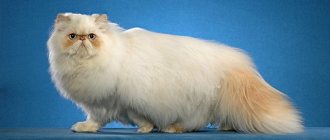The huge Siberian cat, adapted to the harsh climate, lives on the vast territory of the Siberian region of Russia. These owners of the Taiga, together with other animals, adapted to difficult living conditions, learned to get food, catch birds and small animals.
Living with humans, they exhibit hunting instincts and have become assistants in getting rid of rodents. Siberian cats have received recognition as the best rat catchers. These long-haired beauties are smart, have a balanced character and get along well with all family members.
History of the Siberian cat breed
global $ads_google;
//data-ad-slot=”2475549904″ $ads_google = empty($ads_google) ? false : true; ?> if ($ads_google == false) {?> $ads_google = true; ?> } ?> There are no special legends or secrets in the origin of the Siberian cat. The native Russian fluffy cat inspired Russian felinologists in 1980 to select a breed of cats, registered by clubs as Siberian. These were often semi-long-haired creatures, which became breeding material.
At first, the beauties remained popular only within Russia, but history puts everything in its place, and the beauty and amiable nature of the Siberian cat attracted the interest of foreign lovers of meowing creatures. Soon the wonderful cats began to be exported to other countries and the fluffies saw the Czech Republic, the USA, and Germany. There were also difficulties: not everyone was satisfied with the vague description of the cats.
By 1991, an international standard for a new breed had been approved, which remained popular only within Russia. Work to clarify the difference between Siberians and other purebred cats continued. The last approved standard was adopted in 1994, and it is still relevant today. Changes in the description affected the shape of the head and the description of the unique water-repellent three-layer coat of these cats.
History of the breed
How the forest cat appeared in Siberia is practically unknown; there are only assumptions that they were brought by merchants from Bukhara. Other versions of their origin have been found untenable.
Smart animals, with the ability to destroy rodents, have taken root in the homes of Siberian residents. Adapting to the harsh conditions of Siberia, they gradually acquired long hair, and fur patches grew on their paws to protect them from frost.
Siberian handsome cats, huge in size, were chosen by merchants from the central regions of Russia. So, around the 16th century, Siberian cats found their way into big cities and villages, becoming palace residents and inhabitants of village huts.
At the end of the 20th century, surprisingly large cats attracted attention in the Russian philological community. The Siberian cat was registered as an independent breed only in 1987. A specific standard describing the characteristics of the Siberian cat as a breed was received in 1991 and was included in the lists of felinologists of the World Cat Federation. Finally, the Siberian cat breed received a standard, which was recognized by the TICA organization in 1996 and FIFe in 1997.
Description of Siberian cats
The Siberian cat rightfully bears the title of Russian beauty. She looks lordly and presentable thanks to her well-developed large body with powerful paws. Small tufts of hair grow between the Siberian's toes.
The head is large and appears to be trapezoidal with rounded corners. According to the breed standard, the distance between the ears should correspond to the width of the ears. At the tips of the ears there are tassels, giving the muzzle a resemblance to a lynx.
The characteristics of the muzzle require harmony with the body of the body, so no points are allowed. The back of the head should be flat. By the shape of the head it is not difficult to distinguish a true Siberian from another similar breed. In addition, a smooth transition from the nose to the forehead is noticeable, and the Persian can no longer be passed off as this breed.
The description of the standard indicates large and round eyes with an expressive gaze.
A unique wool caftan is formed around a powerful, strong neck. Impressive shoulders exceed the width of the body. The body itself is superbly developed. Such power is considered a feature of the breed - any cat will be an excellent rat catcher and can compete in strength with some dogs.
The tail of cats is very fluffy and wide, but moderately long.
global $ads_google; //data-ad-slot=”2475549904″ $ads_google = empty($ads_google) ? false : true; ?> if ($ads_google == false) {?> $ads_google = true; ?> } ?>
A sign of a purebred Siberian cat is thick, rather hard hair. These long-haired cats can be recognized by examining their coat: since it consists of two layers of undercoat and is stiff, it does not get wet. The hind limbs are dressed in thick, warm “pants.”
Those who decide to get a small or adult Siberian can be calm about the occurrence of allergies - the breed, despite its long hair, is defined as hypoallergenic.
The combined color of the cat is ideal for the wild conditions of Siberia. The color is noticeable from the first month of life and can be patterned or solid; a variety of colors are allowed, including black and white.
Sizes and weight of Siberian cats
Since these are cats with heavy, massive bones, then, despite their average size and dimensions, their not entirely light weight cannot be small. The height of an adult animal at the withers reaches 30 cm if it is a female, and 40 cm for a male.
The kitten gains weight from month to month, usually well, and nevertheless, the cat grows for a long time: the formation of all body parameters, weight and length is completed by the age of three or even five years.
When buying a cat from Siberia, you should ask how much it will weigh: males weigh heavily and amount to 6-8 kg, females are lighter.
Their weight does not exceed 5 kg. Table of approximate weight of a Siberian cat by month
| Age | Female | Male |
| newborn | 60-130 gr | 70-150 gr |
| 1 month | 350-550 gr | 500-740 gr |
| 2 months | 590-1100 gr | 950-1450 gr |
| 3 months | 1-1.5 kg | 1.4-2.6 kg |
| 4 months | 1.6-2.5 kg | 2.1-4 kg |
| 5 months | 2.2-2.9 kg | 2.7-4.6 kg |
| 6 months | 2.7-3.3 kg | 3-5.1 kg |
| 8 months | 3-3.8 kg | 3.6-5.8 kg |
| 10 months | 3.5-4.2 kg | 4.3-6.2 kg |
| 1 year | 3.8-4.7 kg | 5.2-7 kg |
| 2 years | 4-5kg | 6-8 kg |
General characteristics, breed standard
All associations have a common characteristic of the Siberian beauty: a powerful, muscular animal of medium to large size, with a good-natured expression on the face, and semi-long hair. Animals of late development - the final formation of an individual is completed by the age of five.
Description of the external characteristics of the Siberian Cat breed according to the TICA felinological system:
- Head. Triangular with rounded transitions. The forehead is wide, the chin is narrow. The cheeks are large and rounded. The forehead is flat and goes smoothly to the nose.
- Ears. The middle ones, widely spaced, taper to a rounded tip. Slight lean forward. The inside is heavily pubescent, tassels at the ends are welcome.
- Nose. Medium length and width, the transition line from the forehead to the nose is smooth with a slight break. In line with the chin.
- Chin. Well developed, strong, round.
- Mustache. The pods are clearly defined and well developed.
- Eyes. Round shape, round is acceptable. Slightly narrowed towards the outer corner. Any color, regardless of coat color.
- Neck. Powerful, medium length. Visually it appears shorter due to the large fur collar.
- Body. The skeleton is medium, the muscles are well developed. The back is wider than the front. Gives the impression of power, heaviness and strength, especially in cats.
- Paws. The hind ones are longer than the front ones. Length - medium, wide and powerful, pads with edge between fingers, powerful.
- Tail. Shorter than the body length, wide, evenly pubescent, rounded tip.
- Wool. Consists of semi-long main hair - hard and shiny, with water-repellent properties. Double undercoat. Its density depends on the time of year. In warm weather - short, in winter and autumn - voluminous, long, very warm. Characterized by a lush “collar”, wide “pants” on the hind legs, and a plumed tail. Subject to seasonal molting.
- Colors. Numerous and varied - black, blue, red, tortoiseshell, tabby, others.
- Weight. They differ greatly by gender. In females up to six, in males - up to twelve kilograms.
- Crossbreeding is only allowed within the breed.
Disadvantages: poorly formed center hair or undercoat of insufficient length. Poorly developed cheeks, chin, body. Ears that are set too close together are too long and small and low. Short tail, small paws, graceful build, too long neck.
Disqualifying signs:
- excessively even profile or snub nose like the Persians;
- elongated narrow head, creating the impression of lightness;
- small, deep-set eyes;
- poor wool quality, poor health.
Habits and character of Siberian cats
For breeding purposes, cats were once taken from harsh natural conditions, and this affects the character and habits of many generations of cats. This is an active and courageous hunter who will become a threat to all rodents in the house and in the area, and even the neighbor’s rabbits. The pet will enthusiastically bring both prey and some other thing in its teeth.
global $ads_google; //data-ad-slot=”2475549904″ $ads_google = empty($ads_google) ? false : true; ?> if ($ads_google == false) {?> $ads_google = true; ?> } ?>
Judging by the reviews of satisfied owners, the Siberian cat is fearless and loves to defend its territory from uninvited guests in the form of strangers and strange animals. They also have no fear of dogs. The family pet will not be scared by sharp sounds. You can be calm, the cat will not get into trouble without a good reason - the nature of the animal requires you to first check whether everything is safe.
The intelligence of the breed allows you to begin not only raising, but also training your pet in early childhood. There will be no problems with obedience and toilet training.
Raising this furry animal is a real pleasure. They are not picky and willingly play games with any item offered. Families with children like these characteristics.
The description of the character of the four-legged roommate also includes the words “discreet, affectionate, attentive.” Friendship with an animal is possible only if there is mutual respect for each other’s personal space, so if your pet has climbed high up to the ceiling, let him sit there as long as his feline heart desires.
Character
Siberians have won great respect for their independent, proud, but absolutely not arrogant character:
- Excellent and strong hunters, they will forever rid any home of rats and mice. They will destroy them completely and scare them away forever. This instinct is so highly developed that it surpasses it even in dogs. A Siberian cat is capable of catching a rabbit, a large bird, and a hamster. Therefore, caution should be exercised when introducing him to parrots or rodent pets.
- They are silent, but are able to warn the owner of danger. Absolutely fearless, like faithful dogs, they will rush to protect a child or owner from strangers.
- Siberians are very smart and easy to train. They will most likely refuse the harness due to their independent temperament.
- Not picky at all. They eat everything, play with any object.
- They love heights very much. Capable of high jumps. Strong powerful paws and a natural sense of balance allow these hunters to be considered excellent climbers.
- They are attached to one owner, but they know and love all family members. At the same time, they are absolutely not intrusive; they will leave at the slightest hint that they are tired of them.
- They are friendly and peaceful - they get along well with small children and with representatives of other animals.
Feeding and caring for Siberian kittens
Surprisingly, such a thick coat of the breed does not require endless care. The grooming process includes brushing during the molting period, otherwise 1-2 times a month will be more than enough.
The animal's ears and eyes are cleaned once a week with damp, clean cloths or napkins. Nails need to be trimmed 1-2 mm as they grow, 2 times a month.
Proper maintenance of a Siberian cat requires that you sometimes let it go outside.
Feeding a Siberian kitten must be done in strict accordance with the nutritional plan developed by veterinarians. The genetic program of the breed requires a natural and varied diet, which the owner must take care of.
An important thing in the diet is that the food should contain a large amount of protein, especially during the growing period of kittens. Enhanced protein nutrition is important during the first three years; during this period, you need to feed the cat so that the protein in the diet is about 70%. After this, the protein level is reduced to 50%.
Features of care and maintenance
Very warm wool with excellent water-repellent properties requires special conditions for keeping and caring for your pet:
- These animals need quite long walks outside. It is more convenient to keep such a handsome man in a private house. And in urban conditions, the owner needs to walk him.
- They are toilet trained well, but prefer to relieve themselves in the fresh air. In an apartment, it makes sense to place the tray on a balcony or loggia.
- You should not trim your pet's claws - the hunter's instinct may suffer. The cat is learning to use a scratching post very well.
- Your pet's coat needs careful care only during shedding - in spring and autumn. Then it should be combed at least twice a week. First, with a sparse metal comb, then with a characteristic massage brush with frequent metal teeth. Remove any remaining loose hair with special gloves. For shine, rub a velvet napkin over the fur coat.
- The Siberian does not need bathing, although he is not afraid of water.
- The condition of the ears and eyes should be monitored by examining and, if necessary, cleaning them weekly.
Health of Siberians
global $ads_google;
//data-ad-slot=”2475549904″ $ads_google = empty($ads_google) ? false : true; ?> if ($ads_google == false) {?> $ads_google = true; ?> } ?> Like a true Siberian, the cat pleases the owner with its excellent health. Only the owner can damage this natural quality through his careless actions and illiterate care. For example, it is enough not to complete all vaccinations according to the vaccination schedule on time, and a once healthy Siberian cat can contract a serious disease. Even if a cat does not have a walk, it does not mean that at home he lives in complete safety from all diseases.
When the time of puberty comes, and this is approximately 7-9 months, you need to decide whether to breed in the future, because it may be worth castrating or sterilizing an animal from which offspring are not planned. If mating does take place, then pregnancy occurs, lasting 63-69 days.
Siberian cats live 10-15 years.
Breeding work
The global popularity of the Siberian cat is growing, and breeding nurseries, engaged in breeding, are moving towards improving the breed. The so-called traditional colors and the Neva masquerade cat (Siberian colorpoint) have recently become the most popular - many breeders specialize in these varieties of Siberians.
Neva Masquerade - the fruit of love between Siberian and Siamese cats
The Neva Masquerade cat is a young independent breed created on the basis of the Siberian cat; it combines all six varieties of point colors, which are unacceptable according to the Siberian breed standard. Initially, these blue-eyed fluffy cats appeared as a result of the hybridization of Siberian and Siamese breeds, but in many respects they are still classified as Siberians.
Breeding Features
Siberian cats are endowed with very strong genetics and an amazing ability to reproduce. They are prolific - one litter can have from five to ten kittens, which almost never happens in other breeds. Male Siberians do not lose their reproductive qualities until they are eleven or twelve years old, and females do not lose their reproductive qualities until they are eighteen years old. Of course, at this age, owners should not allow offspring to appear - this is too difficult for an elderly animal.
Siberian cats retain reproductive abilities into old age
The selection of healthy sires with good heredity plays a primary role in breeding work. In addition, for breeding Siberian cats it is very important to navigate the genetics of colors, which are so richly represented in this breed.
Table: possible colors of Siberian kittens in the litter
| Cat | Cat | Kittens-cats | Kitten cats |
| Black | Black | Black Blue | Black Blue |
| Blue | Black Blue | Black Blue | |
| Red | Red Cream | Tortoiseshell Blue-cream | |
| Tortoiseshell Blue-cream | Cream | Red Cream | |
| Tortoiseshell | Black Blue Red Cream | Black Blue Tortoise Blue-cream | |
| Blue-cream | Black Blue Red Cream | Black Blue Tortoise Blue-cream | |
| Blue | Black | Black Blue | Black Blue |
| Blue | Blue | Blue | |
| Red | Red Cream | Tortoiseshell Blue-cream | |
| Cream | Cream | Blue-cream | |
| Tortoiseshell | Black Blue Red Cream | Black Blue Tortoise Blue-cream | |
| Blue-cream | Blue Cream | Blue Blue-cream | |
| Red | Black | Black Blue | Tortoiseshell Blue-cream |
| Blue | Black Blue | Tortoiseshell Blue-cream | |
| Red | Red cream | Red Cream | |
| Cream | Red cream | Red Cream | |
| Tortoiseshell | Black Blue Red Cream | Red Cream Tortoise Blue Cream | |
| Blue-cream | Black Blue Red Cream | Red Cream Tortoise Blue Cream | |
| Cream | Black | Black Blue | Tortoiseshell Blue-cream |
| Blue | Blue | Blue-cream | |
| Red | Red cream | Red Cream | |
| Cream | Cream | Cream | |
| Tortoiseshell | Black Blue Red Cream | Red Cream Tortoise Blue Cream | |
| Blue-cream | Blue Cream | Cream Blue-cream |
The genetics of colors are not random accidents
In what cases is sterilization necessary?
The main argument for sterilizing an animal can only be medical indications when it comes to its health or even life. Also, sterilization or castration may become a condition of the breeder when selling a kitten, which he does not consider possible to allow for breeding. It is also impossible to obtain offspring from overly aggressive animals - in such cases, sterilization usually reduces the level of hostility.
All other situations must be carefully analyzed to determine the advisability of the operation - surgery is performed under general anesthesia and can be fraught with serious complications.
Buy a Siberian kitten
It is clear why the Siberian cat has become so popular in Russia and other countries of the world: its external characteristics attract the attention of numerous fans of cats with long hair.
There are enough nurseries where you can buy pedigree Siberians to avoid purchasing a cat with a provenance of dubious quality. If you pick up a kitten from your hands, there is a high probability that it will grow up not into a proud Siberian, but, at best, into a Norwegian forest cat, if you're lucky.
Siberian catteries offer to pre-book a kitten of a suitable class. On average, the cost of the Siberian breed is not particularly high by the standards of the cat market. Purchase cats aged 2.5-3 months, vaccinated and healthy, with the pedigree indicated in the metrics. Buying an inexpensive pet from someone who is supposedly of this breed is fraught with the lack of any documents at all.
The price for cats of the Siberian breed starts at a threshold of 5,000 rubles
and depends on the exterior of the animal and the characteristics of its pedigree.
What to name a Siberian kitten
Choosing a name for a new family friend can sometimes be difficult. When giving a kitten a nickname, people must understand that it should not only please them, but also suit the animal, its external characteristics, and habits. Most importantly, the Siberian cat should easily perceive its name, and, therefore, respond to it easily.
global $ads_google; //data-ad-slot=”2475549904″ $ads_google = empty($ads_google) ? false : true; ?> if ($ads_google == false) {?> $ads_google = true; ?> } ?>
It’s better to come up with a nickname in advance, as the nursery will ask you what name to put on your passport. Many breeders, by old custom, expect the name to reflect the pedigree.
Names for boys and girls can be different, or they can be completely similar. It is worth sitting down and discussing with the whole family what is the best name for a Siberian cat , for this you should use a list of the best nicknames.
Name table
| Girl | Boy | ||
| Redhead Squirrel Cassie Frosya Dara Bonna Athena Mina Shiba Pusha Chunya Laska Eva Zira Rikki | Finn Vyusha Nyusha Rady Basya Vetka Fenya Lada Pear Chishka Dora Plyukha Fanta Kama Era | Chester Maurice Yust Ty Argon Archie Axel Cyber Cruz Bucks Miguel Smokey Pat Fluff Ivor | Erema Patrick Norman Light Evrik Samson Sam Charlie Shrek Cupcake Yukki Veles Karen Murik Nord |
Table: pros and cons of the Siberian breed
| Breed Features | pros | Minuses |
| Character | Calm and balanced | Sometimes vindictive, vindictive and aggressive |
| Content | Easy to maintain and care | Requires regular brushing and walking |
| Nutrition | Can eat both ready-made food and natural food | Tends to overeat and is picky about food |
| Health | High resistance to diseases | Predisposition to joint pathologies |
Conclusions about the breed
The Siberian cat received the right to wear a unique fur coat, which turned out to be easy to care for. The kitty takes excellent care of her coat herself. Another advantage of the breed is its high health indicator, provided that it is well cared for by the owner.
In a family, a cat quickly becomes a friend to every member of the household: it plays with children, gets along with other pets, and unobtrusively offers its company to everyone. In return, she expects only affection and attention!
Description of the breed
Thanks to its luxurious long-haired fur coat, the Siberian cat looks like a true gentleman. They have a large appearance, a pretty face with a luxurious frill-type collar.
All the appearance features and characteristics of the Siberian cat breed are reflected in the table.
Table No.1 Description of the breed
| Siberian cat. Country of origin: Russia, year of recognition: 1987. | ||
| External data | Description | Note |
| Body, body, chest | The dimensions of the body are emphasized by the massiveness of the muscular body, which has a proportional, straight back of medium length. The neck is short and rests on the voluminous massive chest. | The overall appearance of the torso makes a powerful impression. |
| Paws, limbs | The limbs are of medium length, with the hind legs longer than the front ones and ending in large paws. | Between the toe pads are tufts of thick fur. |
| Tail | Medium length, wide at the base and tapering to a rounded end. | Fluffy, like a fox's tail, the real pride of a Siberian cat. |
| Head, muzzle | It has the shape of a trapezoid, narrower at the bottom. The nose with a slight curvature smoothly blends into the forehead. The muzzle has a rounded outline with full cheeks and a pronounced chin. | The appearance of forest cats was formed thanks to the severe Siberian frosts. |
| Eyes | The large eyes are set wide apart and have an oval teardrop shape. The look is intelligent, expresses curiosity and seriousness. | Eye color is green or yellow-amber. |
| Ears | The ears can be medium or large, slightly rounded and tilted forward. medium to large ears are round in shape and slightly tilted forward. The inside of the ear is covered with short hair. | The tips of the ears may have tufts, like those of a lynx. |
| Wool | Siberian cats are a long-haired breed. The winter coat is much longer than the summer coat. There are “pants” on the hind legs. There is a fluffy collar on the neck. The undercoat is denser than the coarse outer coat. | The top coat has water-repellent properties, this property helps in severe frosts. |
| Average height at withers | Approximately 35-40 cm | |
| Average weight | ||
| Average weight of females | from 3.5 to 7 kg. | The average weight of a female is significantly less than |
| Average weight of males | from 6 to 9 kg | |
| average life expectancy | 16-20 years old | Long-term residents with good care live up to 25 years |
Colors
Popular colors of the Siberian breed include both solid colors and various patterns. The table shows the colors that are most common.
Table No. 2 Popular colors of the Siberian cat breed.
| Color type | View | Description of the species | Application |
| Plain (solid) | Black | Intense monochrome color, all hairs are evenly colored from root to tip. | Rare black Siberian cat. Black pigment presented. |
| Red (red) | Yellow pigment present. | ||
| Clarified solid | blue | The Siberian blue cat is especially prized. | |
| cream | A light, delicate shade is preferred. | ||
| Neva Masquerade | Color point: | A separate breed with blue eyes has been identified. | It has not received recognition in all international associations. |
| Multicolored | Tortoiseshell color | A combination of spots of white with evenly distributed spots of black and red or blue and cream shades. | Tricolored females are more common than males, which are usually sterile. |
| Tabby (wild) | Marble | alternation of dark and light pigments in a certain pattern. | Widespread colors. Forms patterns and designs on wool |
| brindle | A combination of dark and light stripes. | ||
| Spotted | there are small snow-white spots. | ||
| Chinchilla These are very rare and valuable colors | Smoky | The uncolored white base of the hairs is combined with a colored tip. | Smooth color without patterns |
| Silver | Consists of 2 stripes, light at the very base and dark at the tips. | They do not have a clearly defined pattern. | |
| Gold | The ends of the hair are colored apricot. | ||
| Basic white | Pure white | Beautiful, solid, intense white color. | Very rare |
| Bicolor | the triangle on the muzzle goes down smoothly from the bridge of the nose to the chest, onto the stomach. The inside of the limbs is also white. | From 1/3 to 2/3 of the total coat is white | |
| Harlequin | tail and spots on head, back and legs | 2/3 -5/6 of the coat remains white. | |
| Wang | Only the tail and 2 spots on the head are colored | 90% white. | |
| Unacceptable colors. | · lilac, · faun, · chocolate, · cinnamon, · cinnamon. | Have not received recognition in all international associations. | They are treated according to the standard of marriage. |
